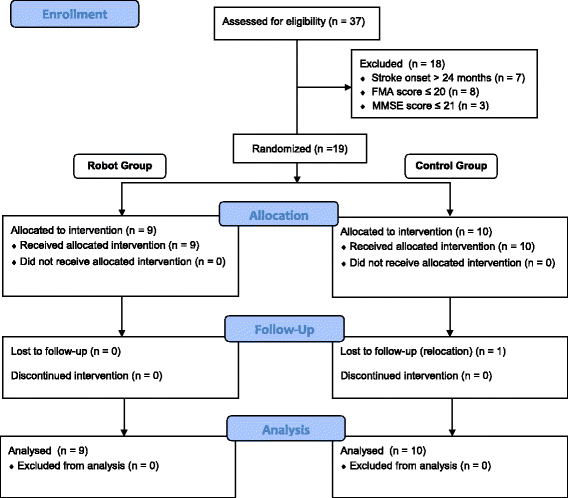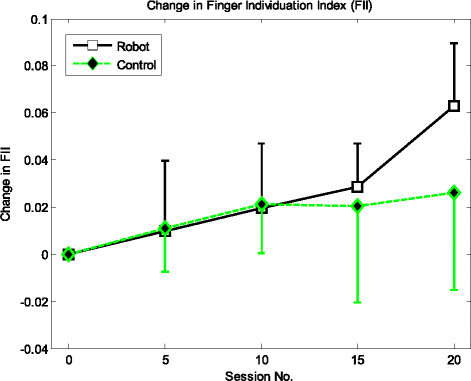Efficacy of robot-assisted fingers training in chronic stroke survivors: a pilot randomized-controlled trial
- PMID: 25906983
- PMCID: PMC4422529
- DOI: 10.1186/s12984-015-0033-5
Efficacy of robot-assisted fingers training in chronic stroke survivors: a pilot randomized-controlled trial
Abstract
Background: While constraint-induced movement therapy (CIMT) is one of the most promising techniques for upper limb rehabilitation after stroke, it requires high residual function to start with. Robotic device, on the other hand, can provide intention-driven assistance and is proven capable to complement conventional therapy. However, with many robotic devices focus on more proximal joints like shoulder and elbow, recovery of hand and fingers functions have become a challenge. Here we propose the use of robotic device to assist hand and fingers functions training and we aim to evaluate the potential efficacy of intention-driven robot-assisted fingers training.
Methods: Participants (6 to 24 months post-stroke) were randomly assigned into two groups: robot-assisted (robot) and non-assisted (control) fingers training groups. Each participant underwent 20-session training. Action Research Arm Test (ARAT) was used as the primary outcome measure, while, Wolf Motor Function Test (WMFT) score, its functional tasks (WMFT-FT) sub-score, Fugl-Meyer Assessment (FMA), its shoulder and elbow (FMA-SE) sub-score, and finger individuation index (FII) served as secondary outcome measures.
Results: Nineteen patients completed the 20-session training (
Trial registration: HKClinicalTrials.com HKCTR-1554); eighteen of them came back for a 6-month follow-up. Significant improvements (p < 0.05) were found in the clinical scores for both robot and control group after training. However, only robot group maintained the significant difference in the ARAT and FMA-SE six months after the training. The WMFT-FT score and time post-training improvements of robot group were significantly better than those of the control group.
Conclusions: This study showed the potential efficacy of robot-assisted fingers training for hand and fingers rehabilitation and its feasibility to facilitate early rehabilitation for a wider population of stroke survivors; and hence, can be used to complement CIMT.
Figures



References
-
- Mackay J, Mensah GA. The Atlas of Heart Disease and Stroke. Geneva, Switzerland: World Health Organization; 2004.
-
- WHO . The World Health Report 2003: Shaping The Future. Geneva, Switzerland: World Health Organization; 2003.
Publication types
MeSH terms
LinkOut - more resources
Full Text Sources
Other Literature Sources
Medical

